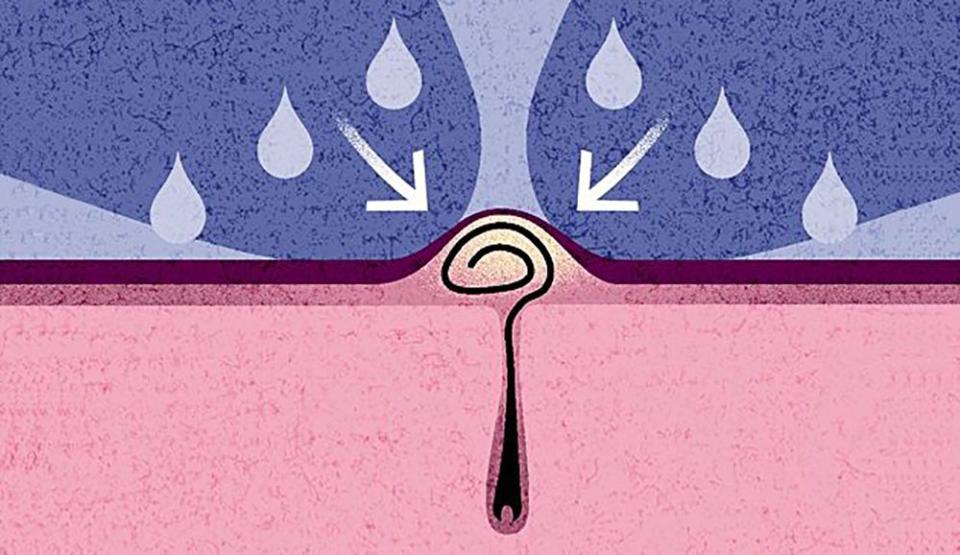You're Probably Getting Rid of Ingrown Hairs the Wrong Way

If you like to keep things trimmed up down there, you know just how annoying those itchy and bright red razor bumps can be. But what if one of those bumps start to grow bigger and bigger, becoming more painful and tender to the touch?
It’s possible you have an ingrown pubic hair, which simply means one of the hairs around your bikini line and on your vulva had trouble growing out properly. While they’re typically harmless, contending with one of those suckers is not fun, to say the least. (Note: many different bumps can form around your vagina, so it’s best to talk to a dermatologist to make sure that you’re actually dealing with an ingrown hair.)
To return your skin to its former glory, you’ll have to understand why you’re getting ingrown hairs in the first place. This way, you can prevent them from popping up again. Already have an angry bump? Here, experts explain what you can do to make an ingrown pubic hair heal faster.
What are ingrown hairs-and why are they so common around your bikini line?

It starts with your grooming routine. When you shave, you’re usually only cutting off your pubic hair where it meets your skin, so it tends to grow back pretty quickly. But when you try to get a super-close shave, you can cut the hair below the surface instead.
“Shaving causes micro-trauma, especially when you use double- or triple-edge razors,” says ob-gyn Deborah Bartholomew, MD, professor and director of the vulvar clinic at The Ohio State University Wexner Medical Center. “They’re often used inappropriately by shaving against the direction of hair growth and stretching the skin to get a close shave.”
That’s why ingrown pubic hairs are so common: It’s not because the hair that grows down there is necessarily coarser, but the complications surrounding shaving are more likely to harm your skin. (Although, people with naturally curly hair are more prone to ingrown hairs.)
When a normal hair starts to grow back, it just shoots up and out of its follicle. But with ingrown hairs, the hair misdirects and grows back into the skin, curling up and underneath the surface. This causes inflammation and produces a painful dark pink or red bump that is around 3 to 4 millimeters in diameter, explains Adeeti Gupta, MD, founder of Walk In GYN Care. Sometimes they are itchy or look like a whitehead because they can fill with pus. You may even see the hair itself-a dark spot right in the center.
You’re definitely not alone if you get one. More than 80 percent of women groom their pubic hair, per a 2016 study published in JAMA Dermatology, mainly because it’s seen as more hygienic. Catch is, research has shown that the practice is associated with damaged skin around the bikini area, most often razor burn and ingrown hairs.
How to get rid of an ingrown pubic hair

Ingrown hairs can really develop anywhere, but the ones around your bikini line can be especially painful. While it’s tempting to try to pop it because they can look like a pimple, you need to keep a hands-off policy. “Do not squeeze it, do not pick it, do not to anything to it,” Dr. Bartholomew says. Popping or picking can easily spread bacteria and result in an infection.
“Every other month we have a woman in the ICU with a vulvar abscess,” she adds, which is a pocket of pus that can form after an infection. “We have seen this in young women because of shaving. It can be very serious, requiring a large amount of tissue to be removed.” Yikes.
If you don’t do anything to it, the ingrown hair will most likely “grow out or just sort of die inside,” says Dr. Gupta. However, there is one thing you try: apply a hot compress on the area a couple times a day, which will encourage the hair to emerge, says Dr. Bartholomew. Within 48 hours it should start to look smaller and feel better. If it doesn’t and remains big and sore or seems to be getting worse, see your gynecologist or dermatologist who can discuss your options with you.
How to shave pubic hair to prevent ingrowns
Want to keep your skin smooth and healthy? Your best bet is preventing those angry bumps in the first place. Keep these tips in mind next time you decide to shave.
Shave with a single blade
A single-edge razor is best if you insist on shaving, says Dr. Bartholomew. Make sure to replace them often and to opt for high-quality blades, not disposables, as the blades are smoother, sharper and more likely to actually cut the hair, not tug at it. Use this razor on your bikini line only and keep a separate one for your legs and armpits to avoid transferring bacteria back and forth.
Go with the grain
Move the razor in the direction your hair grows-not against it-to avoid further irritation. Avoid tugging at your skin as well.
Try trimming instead
A clipper (yes, like a beard trimmer) can be a good option if you constantly deal with ingrown pubic hairs, says Dr. Bartholomew. “It won’t cut the hair as short, so you have to use it more often, but it won’t damage your skin,” she says.
As for other hair removal methods? Waxing is a slightly better than shaving but can still lead to ingrown hairs. Depilatory creams (aka hair removal body creams) are not tested on the vulvar area, and may cause irritation, so skip these, too, says Dr. Bartholomew. Laser hair removal can be an effective solution, but just note that it’s a bit pricier and requires multiple sessions before you get the results you’re looking for.
('You Might Also Like',)

